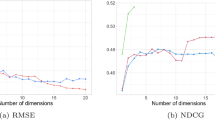Abstract
Most of the common recommender systems deal with the task of generating recommendations for assortments in which a product is usually bought only once, like books or DVDs. However, there are plenty of online shops selling consumer goods like drugstore products, where the customer purchases the same product repeatedly. We call such scenarios repeat-buying scenarios (Böhm et al., Studies in classification, data analysis, and knowledge organization, 2001). For our approach we utilized the results of information geometry (Amari and Nagaoka, Methods of information geometry. Translation of mathematical monographs, vol 191, American Mathematical Society, Providence, 2000) and transformed customer data taken from a repeat-buying scenario into a multinomial space. Using the multinomial diffusion kernel from Lafferty and Lebanon (J Mach Learn Res 6:129–163, 2005) we developed the multinomial SVM (Support Vector Machine) item recommender system MN-SVM-IR to calculate personalized item recommendations for a repeat-buying scenario. We evaluated our SVM item recommender system in a tenfold-cross-validation against the state of the art recommender BPR-MF (Bayesian Personalized Ranking Matrix Factorization) developed by Rendle et al. (BPR: Bayesian personalized ranking from implicit feedback, 2009). The evaluation was performed on a real world dataset taken from a larger German online drugstore. It shows that the MN-SVM-IR outperforms the BPR-MF.
Access this chapter
Tax calculation will be finalised at checkout
Purchases are for personal use only
Similar content being viewed by others
References
Amari, S., & Nagaoka, H. (2000). Methods of information geometry. Translation of mathematical monographs (Vol. 191). Providence: American Mathematical Society.
Böhm, W., Geyer-Schulz, A., Hahsler, M., Jahn, M. (2001). Repeat-buying theory and its application for recommender services. In O. Opitz (Ed.), Studies in classification, data analysis, and knowledge organization. Heidelberg: Springer.
Bradley, A. P. (1997). The use of the area under the ROC curve in the evaluation of machine learning algorithms. Pattern Recognition, 30, 1145–1159.
Cristianini, N., & Shawe-Taylor, J. (2000). An introduction to support vector machines and other kernel-based learning methods. Cambridge: Cambridge University Press.
Deshpande, M., & Karypis, G. (2004). Item-based top-n recommendation algorithms. ACM Transactions on Information Systems, 22(1), 143–177.
Hu, Y., Koren, Y., & Volinsky, C. (2008). Collaborative filtering for implicit feedback datasets. In IEEE International Conference on Data Mining (ICDM 2008).
Lafferty, J., & Lebanon, G. (2005). Diffusion kernels on statistical manifolds. Journal of Machine Learning Research, 6, 129–163.
Lebanon, G. (2005). Information geometry, the embedding principle, and document classification. In Proceedings of the 2nd International Symposium on Information Geometry and its Applications.
Rendle, S., Freudenthaler, C., Gantner, Z., & Schmidt-Thieme, L. (2009). BPR: Bayesian personalized ranking from implicit feedback. In Proceedings of the 25th Conference on Uncertainty in Artificial Intelligence.
Zhang, D., Chen, X., & Lee, W. S. (2005). Text classification with kernels on the multinomial manifold. In Proceedings of the 28th Annual International ACM SIGIR Conference on Research and Development in information Retrieval.
Author information
Authors and Affiliations
Corresponding author
Editor information
Editors and Affiliations
Rights and permissions
Copyright information
© 2014 Springer International Publishing Switzerland
About this paper
Cite this paper
Lichtenthäler, C., Schmidt-Thieme, L. (2014). Multinomial SVM Item Recommender for Repeat-Buying Scenarios. In: Spiliopoulou, M., Schmidt-Thieme, L., Janning, R. (eds) Data Analysis, Machine Learning and Knowledge Discovery. Studies in Classification, Data Analysis, and Knowledge Organization. Springer, Cham. https://doi.org/10.1007/978-3-319-01595-8_21
Download citation
DOI: https://doi.org/10.1007/978-3-319-01595-8_21
Published:
Publisher Name: Springer, Cham
Print ISBN: 978-3-319-01594-1
Online ISBN: 978-3-319-01595-8
eBook Packages: Mathematics and StatisticsMathematics and Statistics (R0)




